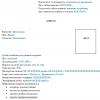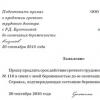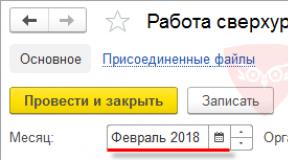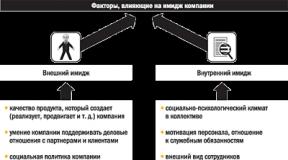Arbidol instructions for use for. Arbidol for children in suspension, tablets and capsules - indications, dosage for treatment and prevention, reviews. Arbidol tablets, instructions for use
Thank you
The site provides background information for informational purposes only. Diagnosis and treatment of diseases must be carried out under the supervision of a specialist. All drugs have contraindications. A specialist consultation is required!
Arbidol represents antiviral drug, which has an additional immunostimulating effect and antioxidant effect. When taken as a preventive measure during periods of seasonal epidemics, Arbidol increases the body's resistance to any viral infections of the respiratory organs. When used from the beginning of an acute respiratory illness, Arbidol shortens the period of high temperature, reduces the severity of symptoms of intoxication and catarrhal phenomena (runny nose, mucus in the throat, etc.), and also reduces the risk of developing complications of influenza. Arbidol is used in children and adults for the prevention and treatment of influenza and ARVI, as well as in complex therapy chronic bronchitis, pneumonia, herpes and acute rotavirus infection. In addition, the drug can be used to normalize the state of the immune system after surgery and to correct immunodeficiencies that have arisen under the influence of negative environmental factors.
Varieties, names, release forms and composition of Arbidol
Currently, two varieties of Arbidol are produced:1. Arbidol;
2. Arbidol Maximum.
Arbidol and Arbidol Maximum differ from each other only in the dosage of the active substance, and in all other parameters they are identical drugs. Accordingly, Arbidol Maximum contains twice the dose active ingredient than regular Arbidol, and therefore it is intended for adults only.
Arbidol is traditionally divided into two main types - children and adults. A drug produced in tablets is considered for children, and in capsules for adults. In fact, such a division into adult and children's Arbidol is rather arbitrary, since both tablets and capsules are produced in the same dosages - 50 mg each and 100 mg each of the active substance. But since the tablets are relatively small, it is believed that they are easier and easier for children to take, since they do not need to quickly swallow a rather large object whole. That is why tablets are considered children's Arbidol. And large capsules are considered adult Arbidol, since only those people who have already learned to swallow rather large objects can take them. And they isolate children's Arbidol in a separate type of medicine in order to leave the drug to the kids in the most suitable and convenient form for them, because adults can take both a capsule and a pill, and children, often only a pill.
In principle, Arbidol tablets are universal, since both children and adults can take them without any difficulties. But adults are better off using capsules to leave the tablets that are most convenient and acceptable to children. However, if capsules cannot be bought for some reason, then an adult may well take children's Arbidol tablets.
Obviously, due to the completely identical dosages with tablets, Arbidol capsules can also be given to children, but only if they can swallow them. In this case, the capsules may well be attributed to a dosage form suitable for use in children, but not optimal. However, since it is still easier for children to take pills rather than capsules, they are considered the optimal form for babies. And capsules can be considered a backup option in case the tablets cannot be purchased for some reason.
Thus, in fact, three types of the drug can be distinguished - these are adult Arbidol, children's Arbidol and Arbidol Maximum. Adult and children's Arbidol differ from each other only in the form of release (capsules and tablets, respectively). Arbidol Maximum differs from children's and adult Arbidol in a higher dosage of the active substance. Since the differences between the varieties of the drug are minimal, in the further text of the article we will use one common name for all of them "Arbidol". We will indicate a specific type of drug only if it is required to focus on its features.
Arbidol Maximum is available in a single dosage form - oral capsules. Arbidol is available in two dosage forms - capsules and tablets. Moreover, the capsules are considered adult Arbidol, and the tablets are considered for children.
 As an active substance, all varieties of Arbidol contain umifenovir, which is also called umifenovir hydrochloride monohydrate or methylphenylthiomethyl-dimethylaminomethyl-hydroxybromindole carboxylic acid ethyl ester. In addition, in many instructions, umifenovir is called arbidol, since this is the multiple name given to this substance by chemists. Just like, for example, the short name for sodium metamizole is analgin.
As an active substance, all varieties of Arbidol contain umifenovir, which is also called umifenovir hydrochloride monohydrate or methylphenylthiomethyl-dimethylaminomethyl-hydroxybromindole carboxylic acid ethyl ester. In addition, in many instructions, umifenovir is called arbidol, since this is the multiple name given to this substance by chemists. Just like, for example, the short name for sodium metamizole is analgin.
Tablets and capsules of adult and children's Arbidol contain 50 mg or 100 mg of umifenovir, and capsules of Arbidol - Maximum - 200 mg. Accordingly, Arbidol tablets and capsules are available in two dosages of 50 mg and 100 mg, and Arbidol Maximum capsules in one - 200 mg.
Capsules Arbidol and Arbidol Maximum contain the following as auxiliary components:
- Colloidal silicon dioxide;
- Potato starch;
- Croscarmellose sodium (only in Arbidol Maximum);
- Calcium stearate.
Capsules of an adult Arbidol consist of titanium dioxide, gelatin, acetic acid, methyl parahydroxybenzoate and propyl parahydroxybenzoate, as well as quinoline yellow and Sun Sunset dyes. Accordingly, due to the dyes, the shell of Arbidol capsules has a yellow color. In some batches of the drug, the casing may consist only of gelatin and titanium dioxide with dyes, without the addition of acetic acid and benzoates.
Arbidol tablets contain the following substances as auxiliary components:
- Hypromellose;
- Titanium dioxide;
- Potato starch;
- Croscarmellose sodium;
- Macrogol 4000;
- Microcrystalline cellulose;
- Povidone;
- Polysorbate 80;
- Calcium stearate.
Arbidol capsules are available in packs of 5, 10, 20 or 40 pieces, Arbidol Maximum - 10 or 20 pieces, and tablets - 10, 20, 30 or 40 pieces.
The 50 mg capsules are completely yellow. 100 mg capsules have one half white, and the other half (cap) yellow. Arbidol Maximum 200 mg capsules are entirely white. In addition, the lower the dosage of the active substance, the smaller the capsule size. Inside the capsules of all dosages, the same crushed homogeneous powder is contained, colored white with a greenish-yellow or cream shade.
The tablets have a rounded biconvex shape and are colored white with a cream shade. At the break, the tablet can be white with a creamy or greenish-yellow tint.
Arbidol - photo

This photo shows the packaging of "adult" Arbidol in the form of capsules.

This photo shows the packaging of Arbidol tablets for children.

This photo shows the packaging of "adult" Arbidol Maximum in capsules.
Therapeutic action
Arbidol has the following therapeutic effects:- Antiviral;
- Immunostimulating;
- Detoxification;
- Antioxidant.
 Antiviral effect the drug is due to its ability to bind to the protein hemagglutinin, which is located on the surface of the viral envelope. It is with the help of hemagglutinin that the virus binds to the cells of organs and systems, penetrates them and causes an active course of the infectious and inflammatory process. It is the penetration of viruses into the cells of the mucous membranes of the respiratory tract that provokes a runny nose, cough, sore throat and redness of the throat, as well as symptoms of intoxication, such as fever, chills, headache, general weakness, malaise, etc.
Antiviral effect the drug is due to its ability to bind to the protein hemagglutinin, which is located on the surface of the viral envelope. It is with the help of hemagglutinin that the virus binds to the cells of organs and systems, penetrates them and causes an active course of the infectious and inflammatory process. It is the penetration of viruses into the cells of the mucous membranes of the respiratory tract that provokes a runny nose, cough, sore throat and redness of the throat, as well as symptoms of intoxication, such as fever, chills, headache, general weakness, malaise, etc. Arbidol blocks the protein with which the virus binds to cells, that is, it actually deprives the microorganism of the ability to cause damage to cellular structures and, accordingly, provoke extensive infectious inflammatory process... Due to this blocking of the ability to bind to organ cells, the virus simply circulates in the blood or is on the mucous membranes of the respiratory tract for a limited period of time during which it is able to live. After which the virus dies.
Due to this mechanism of action, Arbidol, when taken in a prophylactic mode, effectively counteracts the disease with acute respiratory viral infections, quickly blocking even viruses that have fallen on the mucous membranes. And when taken during the period of illness, the drug reduces the severity of the phenomena of intoxication, cough, runny nose and sore throat also due to the fact that it blocks free viruses that have not yet entered the cells. Thanks to this, new viruses do not damage an increasing number of mucosal cells and, thus, do not support the inflammatory process, and the viral particles already in the cells simply die, since their lifespan ends.
It should be remembered that Arbidol does not shorten the recovery period from acute respiratory viral infections, but greatly facilitates their course. Upon admission to initial stages diseases Arbidol often prevents the development of a complete picture of acute respiratory viral infections or influenza, as a result of which the infection proceeds in a very mild, almost asymptomatic form.
Immunostimulating action Arbidol consists in stimulating phagocytosis, during which the cells affected by viruses are destroyed, as well as accelerating the production of interferon. Namely, interferon is a substance that provides an intensive course of various immune reactions aimed at destroying viruses.
Detoxification effect the drug consists in reducing the severity of symptoms of intoxication by blocking damage to new cells by viral particles, as a result of which the amount of decay products of damaged cells in the blood is significantly reduced.
From a clinical point of view, Arbidol has the following effects:
- Reduces the risk of illness during seasonal epidemics of influenza and SARS;
- Reduces the risk of complications from influenza and other viral respiratory infections;
- Makes the course of ARVI and influenza easier;
- Reduces the frequency of exacerbations of chronic infections (herpes, bronchitis, pneumonia, etc.);
- Reduces the risk of developing infectious complications after surgery;
- Accelerates recovery from rotavirus infections in children.
Arbidol: the concept of drug action (commentary by the chief physician of Russia) - video
How Arbidol works - video
Indications for use
Indications for use for all varieties of Arbidol - both for children and adults, are exactly the same, since the drugs are used to treat and prevent the same conditions in people of different age categories.So, children and adults Arbidol, as well as Arbidol Maximum are indicated for use in the following conditions and diseases in adults and children over 2 years old:
- Prevention and treatment of influenza types A and B, including those occurring with complications such as bronchitis and pneumonia;
- Prevention and treatment of acute respiratory viral infections (ARVI, ARI);
- Prevention and treatment of severe acute respiratory syndrome (SARS) that occurs when severe course flu;
- As part of the complex therapy of bronchitis, pneumonia, recurrent herpes infection;
- As part of the complex therapy of acute intestinal rotavirus infection ("stomach", "intestinal", "summer" flu) in children;
- Prevention of infectious complications after surgery;
- Secondary immunodeficiencies.
Arbidol - instructions for use
Arbidol adult and Arbidol Maximum
 Adults are considered Arbidol in the form of capsules with dosages of 50 mg and 100 mg, as well as Arbidol Maximum. These types of the drug can be taken by adults and adolescents from the age of 12. Children under 12 years old can be given Arbidol 50 mg or 100 mg capsules as an exception, if tablets cannot be bought for some reason. Arbidol Maximum should not be given to children under 12 years of age under any circumstances. Accordingly, in this subsection of the instructions for use, we give the schemes and dosages for taking Arbidol and Arbidol Maximum for adults and adolescents over 12 years old. Schemes for using the drug in children under 12 years of age will be given in the subsection with instructions for children's Arbidol.
Adults are considered Arbidol in the form of capsules with dosages of 50 mg and 100 mg, as well as Arbidol Maximum. These types of the drug can be taken by adults and adolescents from the age of 12. Children under 12 years old can be given Arbidol 50 mg or 100 mg capsules as an exception, if tablets cannot be bought for some reason. Arbidol Maximum should not be given to children under 12 years of age under any circumstances. Accordingly, in this subsection of the instructions for use, we give the schemes and dosages for taking Arbidol and Arbidol Maximum for adults and adolescents over 12 years old. Schemes for using the drug in children under 12 years of age will be given in the subsection with instructions for children's Arbidol. Capsules are taken orally before meals, swallowing them whole, without biting, not chewing or crushing in other ways, but with a small amount of still clean water (half a glass is enough). A single dosage for adolescents over 12 years old and adults is 200 mg, which corresponds to 2 capsules of 100 mg, 4 capsules of 50 mg or 1 capsule of 200 mg.
For non-specific prophylaxis of influenza, acute respiratory diseases, exacerbations of bronchitis or herpes, and postoperative complications Arbidol and Arbidol Maximum adolescents over 12 years of age and adults are recommended to take in the following dosages:
- If there was direct contact with a person suffering from influenza, acute respiratory viral infections or acute respiratory infections, then Arbidol should be taken 200 mg once a day for 10 to 14 days;
- During periods of mass epidemics of influenza, acute respiratory viral infections and acute respiratory infections, take 200 mg of Arbidol twice a week (every two days) for 21 days;
- To prevent exacerbation of chronic bronchitis or herpes, it is recommended to take 200 mg of Arbidol twice a week (every 2 days) for 21 days;
- For the prevention of severe acute respiratory syndrome (SARS) after contact with an already ill person, it is recommended to take 200 mg once a day for 12-14 days;
- For the prevention of postoperative complications, Arbidol should be taken in a dose of 200 mg 2 days before the planned operation, as well as 2 and 5 days after its production.
- Influenza, acute respiratory infections, acute respiratory viral infections, proceeding without complications - take 200 mg 4 times a day (every 6 hours) for 5 days;
- Influenza, acute respiratory viral infections, acute respiratory infections, occurring with complications (bronchitis, pneumonia, laryngitis, etc.) - take 200 mg 4 times a day (every 6 hours) for 5 days. After that, from the sixth day, they switch to taking Arbidol 200 mg once a week for 4 weeks;
- Severe Acute Respiratory Syndrome (SARS) - take 200 mg 2 times a day for 8 to 10 days;
- Chronic bronchitis and herpes infection - take as part of complex therapy 200 mg 4 times a day (every 6 hours) for 5 to 7 days. Then Arbidol is taken 200 mg twice a week (every 2 days) for 4 weeks;
- Acute intestinal rotavirus infections - take as part of complex therapy 200 mg 4 times a day (every 6 hours) for 5 days.
Arbidol for children - instructions for use
 Children's Arbidol are tablets for oral administration with dosages of 50 mg and 100 mg of the active substance. Children's Arbidol is used at the age of 2 to 12 years, and after reaching 12 years of age, the child should take the drug in adult dosages in the form of capsules. This subsection will provide schemes of use and dosage of Arbidol tablets for children 2 - 12 years old. For children over 12 years old, one should be guided by the doses and schemes given in the subsection above, which provides information on the use of an adult Arbidol.
Children's Arbidol are tablets for oral administration with dosages of 50 mg and 100 mg of the active substance. Children's Arbidol is used at the age of 2 to 12 years, and after reaching 12 years of age, the child should take the drug in adult dosages in the form of capsules. This subsection will provide schemes of use and dosage of Arbidol tablets for children 2 - 12 years old. For children over 12 years old, one should be guided by the doses and schemes given in the subsection above, which provides information on the use of an adult Arbidol. Children 2 to 12 years old should be given tablets a few minutes before meals. The tablet must be swallowed without biting, without breaking, not chewing or crushing it in other ways, but only with a small amount of still water (half a glass is enough). The dosage of Arbidol for a single dose for children 2 - 6 years old is 50 mg, and 6 - 12 years old - 100 mg. In order for a child to drink a single dosage of Arbidol appropriate for age, you can give him the required number of capsules (if he can swallow them) or tablets.
For the prevention of acute respiratory viral infections, acute respiratory infections and influenza after contact with an already sick person it is necessary to give Arbidol to a child 2 - 6 years old, 50 mg, and 6 - 12 years old - 100 mg once a day for 10 - 14 days.
For the prevention of viral respiratory infections (influenza, acute respiratory infections, ARVI, etc.) during a seasonal mass epidemic, as well as to prevent exacerbations of chronic bronchitis and herpes Arbidol should be given to children 2-6 years old, 50 mg, and 6-12 years old - 100 mg twice a week (every 2 days) for 3 weeks.
For the prevention of severe acute respiratory syndrome (SARS) a child 6 - 12 years old after contact with an already ill person is given 100 mg of Arbidol once a day for 12 - 14 days. SARS prophylaxis is not available in children under 6 years of age.
For the prevention of postoperative infectious complications Arbidol is given 2 days before the intervention, as well as on days 2 and 5 after that at a dosage of 50 mg to children 2 to 6 years old and 100 mg to children 6 to 12 years old.
For the treatment of acute respiratory infections without complications , children 2 - 6 years old are given 50 mg, and 6 - 12 years old - 100 mg of Arbidol 4 times a day (every 6 hours) for 5 days. If a respiratory infection proceeds with complications (for example, bronchitis, pneumonia, etc.), then first the treatment is carried out according to the same scheme as for uncomplicated diseases, then for another 4 weeks, once a week, the child is given 2 - 6 years, 50 mg each, and 6 - 12 years old - 100 mg of Arbidol.
For the treatment of severe acute respiratory syndrome (SARS) Arbidol is given to children 2 - 6 years old, 50 mg, and 6 - 12 years old - 100 mg, 2 times a day for 8 - 10 days.
For the treatment of chronic bronchitis and herpes as part of complex therapy Arbidol is given to children 2-6 years old, 50 mg, and 6-12 years old - 100 mg 4 times a day (every 6 hours) for 5-7 days. Then, for another 4 weeks, it is necessary to give Arbidol to a child 2-6 years old, 50 mg, and 6-12 years old - 100 mg twice a week (every two days).
The drug Arbidol for children is a drug that has an immunostimulating and antiviral effect. In medical practice, the drug has been used for a long time.
This is due high efficiency, a wide range actions, the ability to deal with complications arising from untimely treatment.
Arbidol has a minimum of contraindications and side effects, therefore, it is allowed to be used even by the smallest children.
Composition, release form and description
Arbidol for children is available in the form of tablets and suspensions. The former have a dosage of 50, 100 and 200 mg. The color of the tablets is white or cream.
Released in blister plates packed in a cardboard box. Arbidol tablets are intended for children from 3 years old.
The suspension preparation agent in its original form is a granular powder of cream or white color. The composition has a pleasant fruity smell.
The powder is placed in a dark glass container with a 100 ml mark and packed in a cardboard box along with an annotation and a measuring spoon.
Manufacturers also took care of safety: the cap located on the bottle is unscrewed by pressing and then scrolling clockwise.
After preparation, the suspension becomes yellowish-white with a cherry or banana odor.
The active ingredient of the drug is umifenovir.
Excipients contained in tablets:
- croscarmellose sodium;
- hypromellose;
- titanium dioxide;
- potato starch;
- microcrystalline cellulose;
- polysorbate 80;
- calcium stearate;
- macrogol 4000.
Additional components contained in the suspension:
- sodium benzoate;
- sodium chloride;
- maltodextrin;
- titanium dioxide;
- sucrose;
- colloidal sodium dioxide;
- starch;
- sucralose;
- banana and cherry flavors.
Indications

According to the instructions, baby drug Arbidol in the form of a suspension (syrup) and tablets is prescribed for the treatment of children with:
Indications for use also include herpes and rotavirus; a medicine is prescribed in combination with other drugs.
Contraindications
Arbidol is contraindicated:
- children under 2 years of age (suspension);
- children under 3 years old (tablets);
- with intolerance to the components included in the drug;
- children under 6 years of age with indications for nonspecific prophylaxis of severe acute respiratory syndrome (SARS);
- children under 12 years of age with indications for the treatment of SARS.
Before use, you should consult a pediatrician if the baby has problems with the kidneys and liver, with fructose intolerance, sucrose deficiency, diseases of cardio-vascular system.
Parents on a note: you can learn about what they are, how to prevent them from our article.
What a rash looks like with scarlet fever in children, the photos presented in it will also tell.
How and after what time does the drug work?
Arbidol has antiviral, anti-toxic, antioxidant and immunomodulatory effects.
The antiviral effect is characterized by the ability of the drug to combine with the hemagglutinin protein in the envelope of the virus.
It is thanks to hemagglutinin that the virus combines with tissues, organs and causes the development of inflammatory and infectious processes.
The ingress of viruses into the body's systems and causes unpleasant symptoms - a runny nose, headache, otitis media, sore throat, body aches, weakness, chills and fever.
Arbidol blocks the protein, due to which the virus stops multiplying and dies. A drug counteracts the development of infectious and inflammatory processes, instantly blocking viruses that have penetrated even the mucous membranes.
Arbidol is also able to relieve cold symptoms within a few hours after the first dose and ease the course of the disease.
The immunomodulatory effect of the drug is characterized by the activation of phagocytes and the destruction of viruses, an increase in the release of interferons, which are responsible for the immune system's response to viral penetration.
The drug is also capable of:

- reduce the risk of developing diseases during seasonal epidemics (influenza, ARVI);
- reduce the frequency of exacerbations of colds;
- make a flow lung disease and practically asymptomatic;
- reduce the risk of complications;
- cure rotavirus infections in children.
The anti-intoxication effect of Arbidol is to weaken the symptoms of intoxication - weakness, dizziness, headache, chills, etc.
Dosage at different ages
How to take medicine for children with colds, how to drink for prevention, and at what age can you give baby Arbidol to a baby?
For treatment, the drug is prescribed:
- from 12 years old - 200 mg 4 times a day;
- from 6 to 12 years old - 100 mg 4 times a day;
- from 3 to 6 - 50 mg 4 times a day.
This scheme must be adhered to for 5 days. After that, the use of the drug is reduced to 1 tablet 1 time per day. The duration of therapy is up to 28 days.
For prophylaxis, Arbidol tablets are prescribed 1 time per day.
During epidemics colds it is recommended to take the drug 1 tablet 2 times a day. Dosage should be adjusted according to age.
The suspension should be prepared as follows: warm boiled water volume of 30 ml. The container is tightly sealed with a lid and shaken until a homogeneous consistency is obtained.
Then add water to the 100 ml mark and shake again. It is necessary to shake the suspension before each use.

A single dosage of the drug is:
- children from 2 to 6 years old - 10 ml;
- from 6 to 12 years old - 20 ml;
- from 12 years old - 40 ml.
The required dose is measured using the attached measuring spoon.
During an epidemic, the drug is taken 2 times a week for 20 days. Upon contact with a sick person - 1 time per day, 2 weeks.
In the treatment of acute respiratory viral infections and influenza - 4 times a day, 5 days.
Reception scheme, special instructions
For patients with diabetes mellitus you should be careful when taking Arbidol, because it contains sucrose.
If for some reason the appointment was missed, you need to drink the medicine as soon as possible.
The drug is taken 15-25 minutes before meals. with a glass of water.
Price in Russian pharmacies, shelf life, storage and dispensing conditions
Tableted Arbidol is stored at a temperature not exceeding 25 degrees. The suspension is placed in the refrigerator.
The shelf life of tablets and powder is 2 years. The finished suspension is allowed to take no more than 10 days.
The drug is dispensed without a prescription. How much does children's Arbidol cost: the price of tablets is from 170 to 270 rubles, for a suspension - from 250 to 290 rubles.
Children are more difficult to tolerate diseases of a viral nature. The likelihood of developing the disease increases when the child begins to attend Kindergarten or school. In addition, viral infections appear in young patients during the cold season or during epidemics. This is due to the fact that the body of the crumbs continues to develop, and the immunity is weakened during the off-season. It is important to treat your child correctly to prevent complications. For this purpose, it is recommended to use Arbidol at the first symptoms of the disease.
An effective drug that demonstrates antiviral effect is called Arbidol. Most often it is used for influenza and respiratory diseases. In addition, the medication helps prevent viral infections during epidemics. Arbidol strengthens the immune system and exhibits antioxidant protection. The drug is available in different dosage forms and is well tolerated by patients.
Composition and action on the body
Arbidol for children is presented in tablets, capsules and powder. As a rule, children are prescribed pills for the treatment of viral diseases. Although the amount of active substance in capsules and pills is the same. However, the second dosage form is more convenient for small patients. But if the child is already old enough, then he can take capsules. The main thing is to observe the dosage prescribed by the pediatrician.
The suspension looks like a cream-colored powder, which is diluted with water before use. Such syrup is allowed to be taken by patients from 2 years old. The main component of the drug is umifenovir. In addition, the medicine contains additional substances: MCC, pyrogenic silicon dioxide, starch, calcium steric acid, povidone, etc.
To understand how Arbidol works, you need to start from the moment the child is infected. When the virus enters the body, it triggers the production of hemagglutinin (a special protein). With its help, the pathogenic agent attaches to receptors on the cell surface, causing inflammatory reactions. With flu, acute respiratory infections, the pathogenic microorganism affects the respiratory tract, ENT organs.
Viruses multiply in the body, which causes inflammation to grow. As a result, the patient develops a cough, rhinitis, swelling of the mucous membranes, and a sore throat. Arbidol blocks the production of hemagglutinin, which damages body tissues. That is, the drug protects cells from the action of a pathogenic agent, keeping it on the outer shell until it runs out life cycle... As a rule, the virus dies after 3 to 4 days.
Arbidol helps to prevent influenza or acute respiratory infections during mass diseases. The therapeutic effect is due to the fact that the medication blocks the action of the pathogenic microorganism immediately after its penetration into the inner membranes. The drug is prescribed for children with a decrease in the body's immune forces.
Thus, Arbidol demonstrates the following effects:
- antiviral;
- immunomodulatory;
- antioxidant;
- detoxifying;
- reduces the likelihood of complications of viral infections.
In addition, with the timely and regular use of Arbidol, diseases with chronic course.

Appointment of Arbidol
The treatment regimen with the drug is determined by the pediatrician, taking into account the age and clinical picture.
Arbidol is prescribed for children in the presence of the following diseases:
- Influenza (type A, B), respiratory diseases.
- Viral infections that are accompanied by inflammation of the bronchi and lungs.
- After surgery to reduce the likelihood of viruses entering the body.
- Diseases viral etiology with a chronic course (to reduce the frequency of exacerbations of the disease).
According to the instructions for use, Arbidol helps not only to cure, but also to prevent viral infections.
Dosage of pills

Single dose of medication for patients of different ages:
- 3 - 6 years old - 50 mg;
- 7 - 12 years old - 100 mg;
- from 13 years old - 200 mg.
Tablets are sold with different dosages of umifenovir - 50 or 100 mg. The attending physician will help you choose the appropriate concentration for your child.
Arbidol treatment regimens for different diagnoses:
- For the prevention of influenza, acute respiratory infections - a single dose, treatment lasts 10-14 days.
- To prevent viral infections during mass diseases - standard portion for 20 days.
- For flu or colds with a mild course - 4 single doses in 24 hours for 5 days.
- With flu or acute respiratory infections with complications single dose take four times a day for 5 days. Then the tablets are drunk 1 piece in 7 days for 1 month.
The final dosage of the medicine for children will be determined by the pediatrician.
Application of capsules
A single serving of the drug in capsule form for children is no different. Patients from 3 to 6 years old take 1 piece with a concentration of 50 mg umifenovir, children from 7 to 12 years old - 1 capsule of 100 mg, and patients over 13 years old - 2 capsules of 100 mg.

Treatment regimens for diseases with a viral origin:
- For flu, colds, children from 3 years old drink 1 capsule four times, from 7 years old - 1 capsule (100 mg), over 13 years old - 2 pieces (100 mg each) with the same frequency of use. The treatment lasts 5 days.
- To cure influenza, acute respiratory infections with complications, you need to take a standard dose four times a day for 5 days. Then 1 dose of the drug is taken 1 time in 7 days for 1 month.
- To prevent viral infections, children are prescribed 1 serving of capsules twice in 7 days. The total duration of therapy is 3 weeks.
If the child has been in contact with the patient, then a single dose is taken 1 time in 14 days.
Suspension for children
The suspension is sold at the pharmacy less often than other dosage forms. The finished syrup is stored on the lower shelf of the refrigerator for no longer than 10 days. After this period, the medicine is prohibited to use. The solution can be used by patients from 2 years old for medical reasons.
To prepare the syrup, pour 30 ml of warm water into the bottle with the powder after boiling. Then you need to close the lid and shake the liquid to dissolve the contents. Then a little more water is poured into the bottle so that its level reaches the 100 ml mark, close and shake again. After this procedure, the suspension is ready.

A single dose depends on the age of the child:
- 2 - 6 years old - 10 ml;
- 7 - 12 years old - 20 ml;
- from 13 years old - 40 ml.
The solution is taken according to the following scheme:
- For the prevention of colds - a single dose twice in 7 days. The duration of treatment is 20 days.
- To prevent viral infections after contact with a patient - 1 dose for 14 days.
- To cure influenza, acute respiratory infections - a single serving four times. The therapy lasts 5 days.
The final dose of the medicine will be determined by the pediatrician, taking into account the age and individual characteristics of the child's body.
Limitation and contraindications
Arbidol is normally tolerated by children and rarely provokes negative reactions. The drug in the form of tablets and capsules is prohibited for patients under three years of age (including up to a year). And the suspension is not recommended for crumbs under 2 years old. In addition, Arbidol is contraindicated in case of intolerance to its components.

With renal, hepatic, cardiac or vascular insufficiency, the child can take Arbidol, but his condition should be monitored by a pediatrician. In case of violation of the rules of use or the presence of contraindications, a rash on the skin, itching, nettle fever, nausea appears. After the appearance of such symptoms, stop using Arbidol and consult your doctor.
The cost of the drug
You can find Arbidol in all pharmacies in the country, its cost depends on dosage form and volume:
- Powder for making syrup (25 ml) costs from 330 to 350 rubles.
- Pills (50 mg) 10 pcs. - an average of 150 rubles.
- The cost of 100 mg tablets (the same amount) is 190 rubles.
- For 10 capsules (50 mg), you need to pay 180 rubles.
- Pills in a gelatinous shell (100 mg) 10 pcs. cost about 240 rubles.
If necessary, Arbidol can be replaced with a cheaper drug with a similar effect.
Alternative medicines
If there are contraindications, the child is given drugs with a similar therapeutic effect... Popular analogues of Arbidol for children:
- Ingavirin helps fight influenza viruses (type A, B). This medicine is more effective than Arbidol, however, it has more side effects, therefore, it is necessary to obtain the approval of a pediatrician before using it.
- used for the prevention and treatment of viral infections. Stimulates the production of interferon and helps the body fight off pathogenic agents. Designed for children over 3 years old.
- Aflubin is another analogue of Arbidol, which provokes the synthesis of interferon. After taking the drug, the edema of the mucous membrane decreases, the excretion of sputum is accelerated, the temperature is normalized, and the body is cleansed of toxins. For patients up to 12 months, a suspension is used.
- Remantadine does not strengthen the immune system, but it copes well with viruses. The medication is contraindicated in children with liver failure and in patients under 12 months of age.
- Is a homeopathic medicine for the prevention and treatment of flu and colds. With regular use, the likelihood of dangerous complications (bronchitis, pneumonia) decreases.
- Immunal improves immunity, prevents viral diseases, accelerates recovery in the presence of an infection. The drug is contraindicated only in case of allergy to its components. Suitable for patients up to 12 months.

Thus, Arbidol for children is an effective, and, subject to the rules of treatment, a safe drug. Before using it, consult a pediatrician who will select a treatment regimen and dosage. If a child, after taking Arbidol, has side effects then discard it and see a doctor.
Children who have a viral infection are often prescribed Arbidol. The attitude of mothers to this drug is ambiguous. Some begin to give it to babies at the first symptoms of a cold, while others are afraid to use it, confusing it with an antibiotic. Both are wrong, because to accept medicines unreasonably - harmful to health. And if you refuse treatment with direct indications, the healing process will be delayed, and the risk of complications will increase. Let's figure out in which cases Arbidol will help the child's body cope with the disease.
Arbidol is an antiviral and immunomodulatory drug.
When the drug is indicated
Arbidol is prescribed for prevention and treatment:
- influenza types A and B;
- respiratory syndrome in acute and severe course;
- bronchitis in chronic form, pneumonia, recurrent herpes;
- complications of an infectious nature in postoperative period;
- caused by;

The medicine is prescribed for infections of the gastrointestinal tract.
- secondary states of immunodeficiency (the drug normalizes the immune status).
Most often, pediatricians recommend Arbidol to babies with acute respiratory infections, acute respiratory viral infections and flu. The main symptom is rapid up to 38-41 degrees. The earlier the treatment starts, the more effective it will be. Doctors also advise taking the drug during a period of mass infection. viral infections healthy children attending school and preschool institutions.
Drug action
Arbidol has antiviral effect. The drug promotes the synthesis of natural interferon - a protein that is produced in response to the defeat of the body by viruses. It neutralizes hostile microorganisms, making cells of healthy (uninfected) tissues immune to infection.
Human blood contains macrophages. This is the name of the special protective cells that absorb and digest foreign bodies. Arbidol increases their activity and helps them to cope with viruses faster.
The antiviral effect is also due to the fact that the medicine prevents viruses from adhering to healthy tissues. Usually, harmful cells attach to healthy ones with the help of a sticky fatty membrane. But under the influence of the drug, the cell membranes become immune to the sticky secretion, and remain unaffected.
As a result:
- the number of relapses decreases viral diseases;
- immunological indicators return to normal;
- symptoms of acute respiratory infections, acute respiratory viral infections and flu become less pronounced;

Arbidol prevents viruses from multiplying.
- intoxication of the affected organism decreases;
- the duration of the febrile stage and the general duration of the course of the disease is reduced.
Harmful effect on children's organism when used in a correctly calculated dosage has not been identified.
Composition and form of release
Arbidol is available in three forms:
- Capsules 50 and 100 mg of active ingredient (). In a cardboard box 10, 20, 30 or 40 pieces.

The capsules can be given to children over 6 years old.
- Coated tablets 50 mg each (). The package contains 10 or 30 pieces.
- Suspension powder at a dosage of 25 mg in 5 ml ().
Any of these forms of Arbidol can be given to a child when they reach the age of two. But capsules and tablets must be swallowed without chewing, therefore, it is better for babies to prepare a suspension from a powder. It is also more convenient to dose the medicine in this form, because the tablets will have to be broken in half, and it is even more difficult to divide the contents of the capsule into 2 or 4 equal parts.
5 ml of a suspension prepared from a powder contains 25 mg of umifenovir hydrochloride, the main active ingredient. The composition also includes excipients:
- sucrose;
- maltodextrin;
- titanium dioxide;
- table salt;
- aerosil;
- pregelatinized starch;
- sodium salt of benzoic acid;
- sweetener - sucralose;
- flavors ("banana" and "cherry").

The suspension has a sweetish taste and a pleasant fruity aroma.
Children's Arbidol in the form of a powder for the preparation of a suspension is sold in 37 g bottles of dark glass with a volume of 125 ml. There is a mark at the 100 ml level - this is the level to which you will need to pour water before use. The drug is placed in a cardboard box with instructions for use and a measuring spoon.
Attention! You can find the marking Arbidol-Maximum. This adult form(capsules only) with a dosage of 200 mg. Another similar tool is Arbidol-Lance. This medication comes in 100 mg tablet form.
Manufacturers and cost
Approximate prices for Arbidol in Russian pharmacies:
- Tablets 50 mg (10-30 pieces) - 100-470 rubles.
- Capsules 50 mg (10-40 pieces) - 120-960 rubles.
- Capsules 100 mg (10-40 pieces) - 100-1000 rubles.
- Powder (suspension) 25 mg / 5 ml (37 g) - 250-550 rubles.
Pharmstandard is the only one pharmaceutical company, which produces "Arbidol".
How to be treated?
To prepare a suspension of Arbidol from a powder:
- Boil water and wait for it to cool.
- Open the bottle and pour 30 ml of water into it.
- Close it and shake it so that a homogeneous mass forms inside.
- Add water up to the 100 ml mark.
- Shake the bottle again.
Attention! Before each use of the medicine, shake it for 5-7 seconds so that the suspension is homogeneous. Consume before meals.
- 2-6 years old - 2 scoops (10 ml / 50 mg).
- 6 to 12 - 4 scoops (20 ml / 100 mg). If the child can swallow the tablets whole, you can give 2 pieces of 50 mg each. Capsules of 100 mg (1) and 50 mg (2 pieces) are suitable.
- From 12 and older - 8 scoops (40 ml / 200 mg). It is convenient to replace with capsules (2 x 100 or 4 x 50 mg) or tablets (4 x 50 mg).

During the outbreak of epidemics, the drug should be given 2 times a week.
For the prevention of influenza, give the medicine to children in a single dosage according to age, twice a week for 1.5 months. If a child communicates with a sick person, then for prevention, you need to drink Arbidol at the recommended dose once a day for 1.5-2 weeks. In case of symptoms of acute respiratory viral infections and influenza - every 6 hours for 5 days.
Arbidol is also used for the prevention and treatment of a recently emerging viral disease - atypical pneumonia.
Its official name is Severe Acute Respiratory Syndrome (SARS).
Prevention of SARS:
- Up to 6 years old - contraindicated.
- 6-12 years old - 20 ml (4 measurements) once a day for 2 weeks.
- From 12 years old - 40 ml (8 scoops) once a day for 2 weeks.
For the treatment of confirmed SARS in children over 12 years old, Arbidol is indicated in an amount of 200 mg (40 ml of suspension, or 4 scoops). Take 1-1.5 weeks twice a day. Can be replaced with capsules or tablets.
Side properties and contraindications
Arbidol has only 2 contraindications:
- children under 2 years of age;
- individual intolerance to the components of the drug.
Allergic manifestations are the only possible side effects... Occur in isolated cases in the form of skin rash and itching with increased sensitivity to the composition.

Possible allergic reaction the body - a rash or itching.
Arbidol: does it help or not? - reviews of moms
Opinions are divided regarding this medication. Some parents believe that Arbidol is very effective against influenza and other viral infections. Others are convinced that this is just another marketing ploy. Who is right?
Let's take a look at the reviews first.
"Arbidol" - Russian antiviral agent with antioxidant effects. It is taken during exacerbations of viral epidemics in order to prevent and protect the body from infection. Due to the immunostimulating effect of the drug (if you take it, noticing the first signs of the disease), the symptoms will proceed without complications, and the period of the disease itself will be significantly reduced. In addition to preventing influenza, the drug is taken during complex treatment bronchitis and pneumonia, with immunodeficiency caused by an unfavorable environment. According to the findings of the WHO, it is allowed to be taken by children from 2 years of age with severe acute respiratory syndrome (SARS), and it also helps to restore the body's immunity in the postoperative period.
"Arbidol" is available for children and adults, although the conventionality of division is visible to the naked eye: the dose of the active substance in both variants is the same.
Arbidol "is considered for children" in small tablets, it is easier for children to take them. According to the instructions, "Arbidol" tablets are prescribed for children from two to three years old. And the drug in the form of large capsules is suitable for children from twelve years old. In addition to the usual Arbidol, Pharmstandard OJSC also produces Arbidol Maximum, intended for adults: the dosage of the active substance in it is several times higher.
Note! "Arbidol Maximum" is produced in the form of capsules and is not approved for use in children.
Compound
Any "Arbidol" contains umifenovir as an active substance. In some instructions, it is called arbidol - the name of the substance given by the chemists themselves.
The children's "Arbidol", as well as the adult, contains 50 and 10 mg of umifenovir. The auxiliary components in both preparations are different. Designed for children contains more additives, including titanium dioxide, hypromellose, Macrogol 4000, etc. Potato starch, calcium stearate, microcrystalline cellulose and povidone are included in both preparations.
Therapeutic effects
"Arbidol" has three types of effects on the patient's body:
- Antiviral.
- Stimulating strengthening of the immune system.
- Detoxification.
The antiviral effect consists in the ability of the drug to contact the hemaglutinin protein located on the surface of the virus envelope. Thanks to him, the virus connects with cells. internal organs and, having penetrated inside, is the cause of the inflammatory process. It usually causes rhinitis, redness, sore throat and swelling of the throat. Other symptoms of intoxication are weakness, elevated temperature, migraine, etc.
The drug blocks the protein, preventing the virus from entering cells and causing damage. That is why doctors advise taking "Arbidol" not only as prophylactic... It is able to help even when the first symptoms of the disease appear: a virus that is no longer able to contact cells will circulate in the blood or settle on the mucous membrane of the nasopharynx and quickly die. And the inflammatory process will not develop.
"Arbidol" does not shorten the recovery time, but facilitates the course of ARVI. If you take the remedy at the very beginning of the disease, then it will be almost asymptomatic.
The drug acts on the immune system, destroying the affected cells, accelerating the production of interferon in the body. And interferon helps the immune system respond faster to various viruses.
As a result of the use of "Arbidol", toxins are removed from the body - the result of the vital activity of pathogens, which the medicine does not allow to penetrate into the blood.
Instructions for use
According to the instructions, the drug is indicated for children with acute respiratory infections. respiratory tract caused by viruses that are sensitive to drug treatment. In addition, "Arbidol" is used to treat influenza types A and B, herpes, and immunodeficiency. And children over three years old can be treated with "Arbidol" and for intestinal viral infections.

Instruction. Click to enlarge
Application
"Arbidol" for children - small tablets of fifty and one hundred milligrams of active substance, they are prescribed for children from two to twelve years old. From the age of twelve, it is better for a child to take the drug in the form of capsules. In addition, the doses themselves and the schedule for taking the medication change, because in accordance with the instructions, a child over twelve years old should be guided by the regimen of use by adults.
Children from two to twelve years old should take the tablets on an empty stomach, a few minutes before meals. The tablet cannot be chewed, sucked, ground into powder - it is only allowed to swallow it with a little water.
Dosage
A child from two to six years old - a single dosage is fifty milligrams, from six to twelve years old - one hundred milligrams.
Prevention of viral diseases and treatment - the daily rate is different.
Prophylaxis
In order to prevent ARVI and influenza, as well as during contact with a source of infection, children 2–6 years old are recommended to drink fifty milligrams of the medicine per day, and a child from six to twelve years old - one hundred milligrams. The course cannot exceed two weeks.
During the seasonal onset of the epidemic of viral diseases and in order to prevent exacerbations of a number of diseases - herpes or chronic bronchitis - children from two years old are recommended to drink fifty milligrams, and those over six - one hundred milligrams of medicine every two days for 20-21 days ...
In case of contact with a person suffering from severe acute respiratory syndrome and in order to prevent the disease in the baby himself, children over six years of age are prescribed 1 tablet of 100 mg of the drug once a day for two weeks once a day. In children under the indicated age, the prevention of the syndrome is not carried out.
In order to avoid acute infectious postoperative inflammations, "Arbidol" is given to babies two days before the operation, then on the second and fifth days after the operation.

Treatment
- To treat an acute respiratory infection without complications, children are advised to give 1 tablet 4 times a day, with an interval of six hours. The course lasts five days. In case of complications within 5 days, the child is treated according to the same scheme for the first days, and then 1 tablet is given per day for four weeks.
- For the treatment of SARS, babies are prescribed a tablet twice a day, the course lasts from eight to ten days.
- Treatment chronic bronchitis and herpes consists of two stages: at the first stage, children take a tablet of "Arbidol" four times a day, with an interval of six hours. The second stage lasts a month, when you need to drink the medicine with an interval of 2 days.
- When treating with "Arbidol" intestinal rotavirus infections children are prescribed 1 tablet 4 times a day, in a course of five days.

Contraindications
The drug is contraindicated for people with allergies, as well as sensitivity to its components. In case of diseases of the kidneys, liver and cardiovascular system, it is allowed to take "Arbidol" only as directed by the attending physician.
Since the drug intended for adults is categorically contraindicated in children under two years of age, doctors do not recommend that mothers take arbidol during breastfeeding... Its components can enter the baby's body with breast milk.
Use during lactation and pregnancy
"Arbidol" has enough opponents and supporters, but they all consider the drug low-toxic, practically without side effects.
Then why should Arbidol not be taken during breastfeeding and pregnancy without consulting a doctor? The medicine was tested only on animals, since in almost all countries pregnant and lactating women are prohibited from participating in testing medications for moral and ethical reasons, so further research on the effect of Arbidol on the mother and baby has not been carried out. Therefore, young mothers and women who are preparing to become them should be aware of the whole risk they take by taking such a medicine on their own.
The experience of obstetricians and gynecologists gives hope: in the entire history of many years of observation, there have been no abnormalities in the development of the fetus during the administration of "Arbidol" by mothers. The results of experiments on animals were also positive. So the doctor, who still prescribes medication in the early stages of pregnancy, assessed all the risks and is sure that the disease will bring more harm to the mother's body than Arbidol. However, as a preventive measure, it is advisable to use the drug as a last resort, when other methods are exhausted.
Is it allowed to use for nursing mothers?
Analogs
A large group of Arbidol analogues is divided into two different categories: synonyms and analogs proper.
- A group of drugs with the same active substance, in our case, with umifenovir, is called synonyms. These include "Arpetolid", "Immustat", etc.
- Analogs are a group of drugs with different active substances of the same pharmacological group and a similar therapeutic effect, as a result of which various antiviral drugs are considered analogs of arbidol. Including "Alizarin", "Viracept", "Remantadin" and others.




















